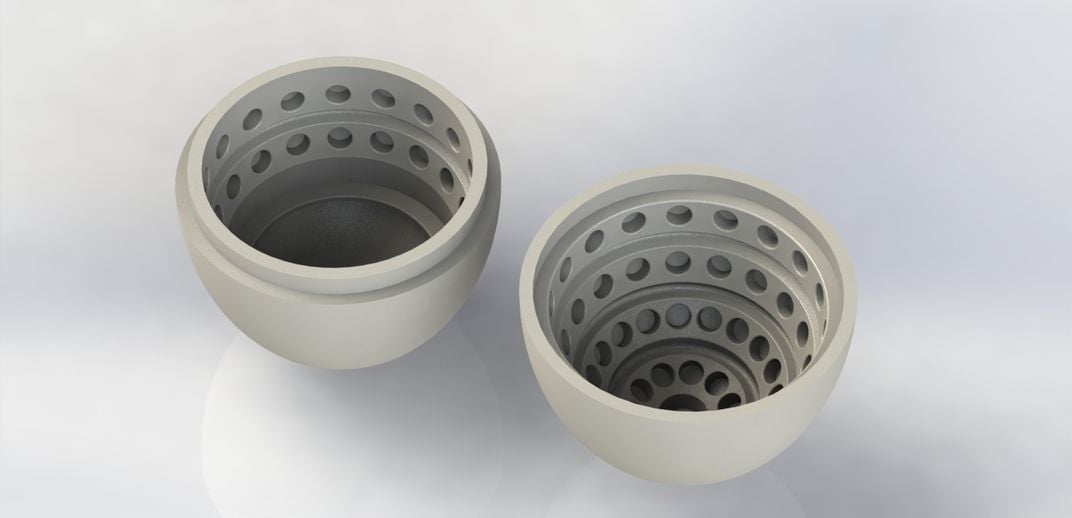Scientists Are Using Electronic Eggs to Study Vultures
A sensor-packed egg, developed by a team at Microduino, could lead to clues about the birds’ livelihood
/https://tf-cmsv2-smithsonianmag-media.s3.amazonaws.com/filer/ca/66/ca660cc3-83c8-4247-8160-587422b5340d/griffon_egg_in_nest.jpg)
Vultures are a crucial part of the ecosystem in places in Africa and India, because their carcass-eating habits keep the incident rates of diseases down. But the scavengers are struggling.
Of the 23 vulture species, 16 are endangered or close to extinction. The Indian vulture has seen 97 percent of its population die off in the last 10 years.
In an effort to protect vultures, scientists at the International Centre of Birds of Prey (ICBP) in the United Kingdom reached out to electronics company Microduino. The conservationists wanted the engineers at Microduino to build an artificial egg packed with sensors to measure its internal temperature, surface temperature, rotations of the egg and other movements, as well as conditions in the nest, including barometric pressure, humidity, carbon dioxide levels and light intensity. This is the most recent step in the ICBP's 15-year-long vulture conservation project, in which they try to protect and breed vultures.
There are several reasons why vultures are struggling, from loss of habitat to poisoning from antibiotics used for cattle. But the population is so sensitive, in part, because the birds lay eggs infrequently. Female vultures tend to lay an egg every year or two, which means their numbers grow slowly. The ICBP started incubating vultures in India in 2010, and while it's going well, it's slow work. So far, they've bread 206 birds in captivity. By using telemetric eggs to evaluate the bird’s incubation habits, scientists can better protect the eggs that are produced.
ICBP sent the Microduino team a photograph of an early mock-up for an egg hooked up to a micro control board. The control board was sticking out of the egg, but it could monitor temperature and humidity and then wirelessly transmit data to the cloud. Bin Feng, Microduino’s CEO, thought he could do better.
Feng and his team set to work making an egg that could house a sophisticated monitoring device and still look and feel like a standard vulture egg. One of the biggest challenges, he says, was battery life.
“The battery life has to be 70 days. The incubation process takes 40 to 60 days, and we need to put the electronic egg in the nest when the mother vulture is away so we don’t disturb them. We need to have a week before and after for data collection,” Feng says. “The power consumption of the whole system is really challenging.”

Electronic eggs have been used to monitor bird behavior before. The National Zoo in Washington D.C. used similar eggs to study the incubation patterns of kori bustards and flamingos starting in 2004. The St. Louis Zoo has used them to better understand duck behavior.
Sara Hallager, the biologist who ran the program at the National Zoo, collected extensive data from the eggs. In a daring swap, she would pluck eggs from flamingo or kori bustard nests and replace them with the electronic ones. The real eggs would then be put in an incubator. The hope was that biologists, learning from the artificial eggs, could mimic the birds' natural incubation process in a safe environment. The researchers found, for instance, that the kori bustards were getting on and off the eggs and turning them frequently during the night. The work was pioneering, but by and large, the biologists couldn’t do much with the information they gathered, because software did not yet exist to do the massive work of thoroughly analyzing it. The egg device was so new, no complimentary data analysis had been developed, which made it hard to turn the research into practice. The zoo eventually ended the program.
“I feel like the data that came out of it was real. It’s a cool story," Hallager says. "I just wish the software was there.”
With the Microduino egg, the data will be uploaded to the cloud. Feng says this cloud collection system will make the data easier to monitor and sort in real time. The team is working on final lab testing now, and the ICBP will likely be field testing the eggs in sites in Africa within the next few months.
“We’re really proud that we’re using Internet of things systems while giving Mother Nature a helping hand in the process,” Feng says. "If it’s successful, we can transfer the technology to other species.”
/https://tf-cmsv2-smithsonianmag-media.s3.amazonaws.com/accounts/headshot/DSC_0196_2.JPG)
/https://tf-cmsv2-smithsonianmag-media.s3.amazonaws.com/accounts/headshot/DSC_0196_2.JPG)